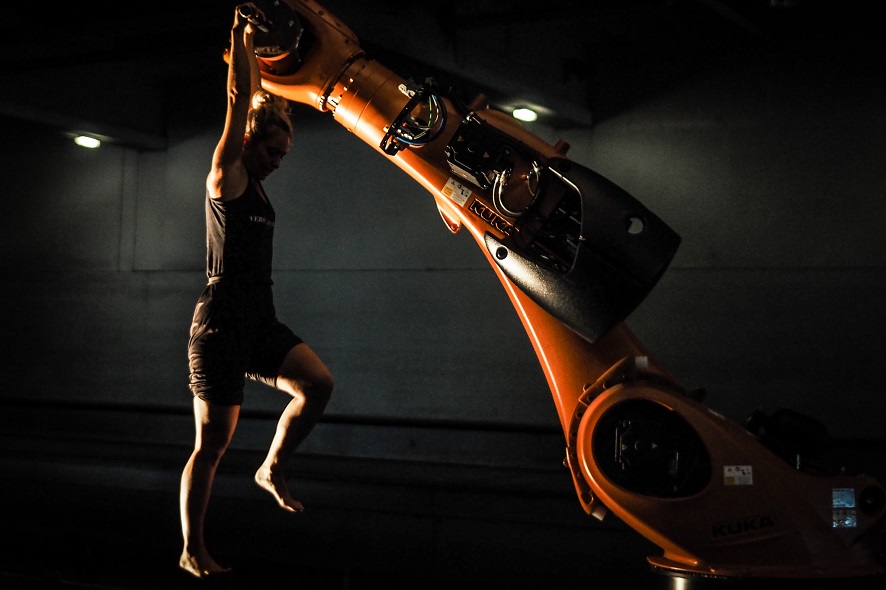The Big Concert Night is one of the absolute highlights of every Ars Electronica Festival. This year’s extraordinary performance on September 9th in Gleishalle, POSTCITY’s decommissioned railroad loading dock, will feature an orchestra, vocal artists, dancers and robots.
Dancer Silke Grabinger and two members of her SILK Fluegge ensemble will provide the performative accompaniment to the Bruckner Orchestra’s rendition of Symphonie Fantastique. In this interview, she talks about the Big Concert Night, her work as a dancer, and the dream of perfection.
At the Big Concert Night, you and two other dancers will perform to Symphonie Fantastique by Berlioz. Tell us more.
Silke Grabinger: The basic concept of the Big Concert Night was developed by Ars Electronica and the Bruckner Orchestra; ours is the third, performative, physical element. The Bruckner Orchestra plays the live music, interpreting the Symphonie Fantastique. Ars Electronica configures the space—there’ll be projections, a digital element as well as an additional body on stage. When we as dancers work, we create a relationship to the audience, to the stage and to the space. Gleishalle is an incredibly beautiful, marvelous space that works extremely well for us. There’s always this spaciousness but, at the same time, you feel yourself as a result of it. So now, when you have this additional body—and I use the term body intentionally—you have to construct a new relationship. This is something we regard as a big challenge—working not only with the orchestra but also with this additional body.
As a dancer, don’t you somehow get lost in such a huge space?
Silke Grabinger: I danced together with SILK Fluegge at the Ars Electronica Festival once already—in a performance entitled “MYGRATION – beget.” The big challenge then was that the audience was seated on one side of the stage and there was a gap between us—we looked across to them on the train platform on the other side. So, I gave a tremendous amount of consideration to lines of sight, and to the incredible acoustics, the reverberation, as well as the lighting conditions in this space. We wanted to reinterpret the post-industrial architecture. Normally, as a dancer, director or choreographer, you’re in a black box. Every different room is a gift because inherent in it are problems that you have to deal with. And if you can do that, then you have the chance to develop something new. For us as performers, this is a challenge; at the same time, we also have to embrace it—in this case, together with the Bruckner Orchestra and Ars Electronica! This offers a lot of possibilities and is really fascinating. So, we’re in this post-industrial space in POSTCITY, contemporary bodies are meeting and interacting, also with the music, with the symphony by Berlioz—so we have manifold possibilities to open up new spaces.

Credit: Florian Voggeneder
Incorporated into this performance are points of contact with robotics, with digital technology, as well as with bodies. How do choreographed movements create expressions about such topics?
Silke Grabinger: This is a matter of striving for quality and perfection in imperfection. There’s the human body, which can do certain things—it can be trained, but you can never repeat a movement 1:1. That’s impossible. I have danced the same solo 1,117 times, and these were 1,117 different versions of the identical sequence of motions. A movement itself can never be perfectly imitated. The search for perfection exists but it’s actually an eternal failure. There are always little errors, inherent in which are new possibilities to interpret things anew. When we’re now involved in a clash with robotics, with an apparently different perfection that also most assuredly has flaws of its own, this too opens up new interpretational possibilities. We’re attempting to approach one another from different directions, but we proceed from fundamentally different make-ups. The music too, the orchestra, attempts to realize the visions of the composer. This is also a search for or an attempt at perfection that fortunately is never achieved because what we’re actually endeavoring to arrive at is ourselves. I believe that the quality and the perfection would ultimately harden us and bring our development to an end; as it is, we’re constantly on a journey.

Credit: Martin Hieslmair
This brings us face-to-face with the festival theme, the Art of Imperfection. How does dance come to terms with imperfection?
Silke Grabinger: I think you have to differentiate between commercial dance and contemporary dance. We’re at the nexus of urban and contemporary dance. We labor in the interstice between perfection and the norms that are the hallmarks of quality of urban dance—How can I be more acrobatic? How can I develop a cool style? How can I express myself better? At the same time, there are also conceptual possibilities of achieving depth, also in the form of sociopolitical reflection, in the theme of the piece. Norms shouldn’t be dogmas with which we constrain ourselves, but rather points on which to orient our doings. And when you have these points of orientation, you can deviate from them and concentrate on something that seems right to you personally, and then quickly turn away from them again!
Why is it personally enriching for you to work with Ars Electronica?
Silke Grabinger: I believe, first of all, it’s because I’m an artist from Upper Austria, which is where Ars Electronica originated. For me, it’s fascinating to repeatedly develop new points of interaction and to see how this propagates further and further and escalates in a way. I also enjoy this feeling of surprise at going so far beyond my limits! Ars Electronica is famous for doing the impossible. We at SILK Fluegge work a lot with digital media and its implementations, and we’re always interested in finding the points of contact to a disembodiment of the digital. We actually work with embodiment, but digital often entails disembodiment. This gives rise to the need to bring the two closer together. I think that’s the reason why we work together so much—mutual interest and many points of contact.

Silke Grabinger is a dancer, choreographer and the artistic director of SILK Fluegge. Her works and concepts combine urban and contemporary dance with performative and visual art. She places particular emphasis on critical encounter with social phenomena, artistic paradigms and the function and/or position of the audience.
Silke Grabinger and two dancers of the SILK Fluegge troupe will accompany the Bruckner Orchestra’s performance at the Big Concert Night. Complete details are available here.
To learn more about Ars Electronica, follow us on Facebook, Twitter, Instagram et al., subscribe to our newsletter, and check us out online at https://ars.electronica.art/news/en/.
